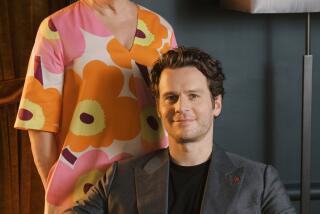Rhapsody in Two
Something’s up.
Sunday afternoon, an early music group joined George Gershwin with Henry Purcell. Sunday night, a cabaret act joined Gershwin with Arnold Schoenberg.
Is Gershwin’s music really so universal that it shakes hands with 17th century English music as well with that of a contemporary German Modernist? Do Gershwin’s blue notes bend on gut strings and hold their own in the face of 12-tone rigor? For the most part, yes.
Although both took place in clubs, the two concerts had nothing to do with each other. The first, sponsored by Chamber Music in Historic Sites, was an appearance by Fuoco e Cenere (Fire and Ashes) and young Israeli mezzo-soprano Rinat Shaham at the Ebell of Los Angeles, once headquarters of the nation’s largest women’s club. The second concert was at the Knitting Factory, a cutting-edge rock and jazz club that was hired out by the Los Angeles Philharmonic for a Schoenberg-Gershwin cabaret, with Michael Feinstein.
“Fantasy in Blue,” the program by Fuoco e Cenere, was the result of a late-night reverie by the ensemble’s leader, wrote Jay Bernfeld in his program note. Recording Purcell at 3 a.m. in Paris, Bernfeld, who is one of the jazzier early music players, suddenly began to feel some of Purcell’s themes had certain Gershwin-esque turns.
It then occurred to him that the two composers led parallel lives. Both died in their late 30s, before they could fully realize their potential. Both were men of the theater, who wrote hit songs with great ease and always had successful shows running on Broadway or Drury Lane. Both had ambitions to be taken more seriously. They were inspired melodists and harmonic colorists.
But the sense of “Fantasy in Blue,” which is also a recording soon to be released in the U.S., is that just about anything works together if you care about it enough to perform it really well.
It was actually only a mild novelty to hear four viols accompany Shaham in “Embraceable You,” and Bernfeld’s elegant embellishments of the melodic line were an easy bridge between Baroque and blues. “A Foggy Day” might have been written for Purcellian viols. A recorder bends notes naturally and Patricia Lavail caught just the right mournful tone for the middle section of the Prelude No. 2.
Shaham added yet another style to the mix. An opera singer a shade too grand for either Gershwin or Purcell, she expressed emotions for the proscenium stage, not an intimate chamber.
But she is also a very persuasive singer, with a gorgeous amber tone and a voice both powerful and flexible. The thrilling passion she brought to “My Man’s Gone” from Gershwin’s opera “Porgy and Bess” and Dido’s Lament from Purcell’s opera “Dido and Aeneas” really did demonstrate kindred spirits across the centuries.
*
Gershwin and Schoenberg actually were kindred spirits and, for the few years they both lived here, Hollywood’s most notable odd couple. They played tennis together.
Although Gershwin never actually studied with Schoenberg, he looked up to him as a student does a master. And Schoenberg--who knew a good tune when he heard one (and wrote a few himself)--took a near paternal pride in the popular composer’s innate musicality.
The Knitting Factory event began with an extended skit by musicologist Christopher Hailey, which dramatized the relationship between Schoenberg (Kurtwood Smith) and Gershwin (Barry Pearl), along with wisecracking pianist and composer Oscar Levant (Michael Tucci)--Gershwin’s best friend and a Schoenberg pupil who brought the two famous composers together.
Leonard Stein, the contemporary musician who was closest to Schoenberg, made a cameo appearance. John de Lancie directed. Everyone was convincing in what could be developed into a marvelous play.
Gershwin visits Schoenberg in his studio. The year is 1937, and Gershwin, recently deceased, is a ghost. Levant is hanging around.
Schoenberg and Gershwin fondly debate music high and low; Levant keeps ghost and master down to earth. Much of the dialogue came from Levant’s memoirs, but also from Schoenberg’s writings. Its witty repartee reveals a great deal about Schoenberg and Gershwin, as men and musicians, and about their times.
Stein, Schoenberg’s assistant, suddenly appears. He sits at the piano and blows everyone’s minds when he reveals that Gershwin’s Prelude No. 1 and the Prelude to Schoenberg’s Suite, Opus 25, both begin with the same melodic motif. It sounds good both ways, 12-tone or blues. (And it also had sounded good, Purcell fashion, when the Gershwin prelude was played on viols earlier in the day.)
For the second half, Feinstein sang Schoenberg’s “Brettl-Lieder,” the cabaret songs the composer wrote as a young man in Berlin. They fall somewhere between Johann Strauss and Kurt Weill, engaging tunes with subtle complexities and licentious texts.
Musically, these songs go beyond Feinstein’s technique. But he had the advantage of an excellent accompanist, Armen Guzelimian, alert to both the humor and the seriousness of the music.
He also had the advantage of knowing how to put over a song in an extravagant fashion. To watch him exploit the sequence of blush-making double entendres in “The Easily Satisfied Lover” (the songs were sung in English translation) is to learn firsthand about the earthy, downright erotic side of Schoenberg that is so often overlooked.
To close, Feinstein sang Gershwin (“By Strauss” and “Of Thee I Sing”) his way--which is 180 degrees from Shaham’s, a world apart from Schoenberg or Purcell. Yet, somehow, it seemed neither more right nor wrong. The performances simply worked on their own terms, which was clearly the lesson of the day and our age.
More to Read
The biggest entertainment stories
Get our big stories about Hollywood, film, television, music, arts, culture and more right in your inbox as soon as they publish.
You may occasionally receive promotional content from the Los Angeles Times.











